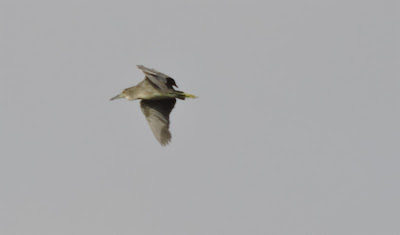Birding here is a little slow at the moment. There is very little movement and the place is left to the residents and summer breeders.
While the monsoon weather could change things slightly, it is still only creeping in slowly.
A visit to Jarziz farm on Friday was the first one I have had this year without any obvious migrants. With all the migrant falcons gone from the farm: Amur falcon, lesser kestrel and even the first Eleonora's falcon for Oman, finally the only bird of prey present was common kestrel.
common kestrel
There were two male birds hovering over the area of the field with recently cut grass.
common kestrel hovering
That in itself is a little different to the Amur falcon and lesser kestrel which show much less preference for the shorter grass.
the second kestrel
As I walked round I flushed up to 80 chestnut-bellied sandgrouse from the scrub near the large field.
chestnut-bellied sandgrouse
As usual the field was heaving with singing bush lark. There must be well over a hundred on site.
singing bush lark
While Forbes-Watson swift were flying over most of the farm, a number of crag martins were flying over the small water reservoir.
unidentified crag martin
One of them had very large mirrors in the tail and dark under-wing coverts. By rights this ought to be a European crag martin. It is only the time of year that makes me doubt this.
pale crag martin
The others were more typical pale crag martin.
scaly breasted munia
The main estrildid finch on the farm is African silverbill. However occasionally I see scaly-breasted munia and that was the case on Friday.
While there was were no more Amur falcon on Friday 26th there were still two on my previous visit on Monday 22nd June. This means they were seen almost continually for 8 consecutive weeks.
The last two were one immature male and one immature female.
Other recent trips have included one to Ayn Hamran on June 23rd. This one was with Michael Immel. Disappointingly the sun was not obscured by any khareef (monsoon) effect and so bird life was subdued in the heat.
The heat did not stop the grey-headed kingfisher from being in evidence though it is difficult for them to hide.
In hot weather near water, it is often good just to stay near the water and watch what visits.
Birds were no only drinking but bathing too. The majority were cinnamon-breasted bunting but white-spectacled bulbul and Abyssinian white-eye visited too.
Arguably the best sighting was not a bird at all. We came across an African wildcat. When it saw us it walked slowly away and promptly sat under a tree and fell into a light sleep. It showed no fear.
It looks reminiscent of a domestic tabby but the white and black tail as well as the black paws are two of the more obvious distinctions.
The same afternoon we paid a quick visit to the north west corner of Khawr Rori. I am ever hopeful of seeing the malachite kingfisher there again.
There was no sight of it. The only slightly unusual sighting were five black-crowned night heron. Three were adult and two were second calendar year birds.
I am travelling a lot this summer and hope to report any any birding I do.
Amur falcon stretching
The last two were one immature male and one immature female.
perched Amur falcon
Other recent trips have included one to Ayn Hamran on June 23rd. This one was with Michael Immel. Disappointingly the sun was not obscured by any khareef (monsoon) effect and so bird life was subdued in the heat.
first grey-headed kingfisher
The heat did not stop the grey-headed kingfisher from being in evidence though it is difficult for them to hide.
second grey-headed kingfisher
In hot weather near water, it is often good just to stay near the water and watch what visits.
bathed white-spectacled bulbul
Birds were no only drinking but bathing too. The majority were cinnamon-breasted bunting but white-spectacled bulbul and Abyssinian white-eye visited too.
cinnamon-breasted bunting
Arguably the best sighting was not a bird at all. We came across an African wildcat. When it saw us it walked slowly away and promptly sat under a tree and fell into a light sleep. It showed no fear.
African wildcat sleeping
It looks reminiscent of a domestic tabby but the white and black tail as well as the black paws are two of the more obvious distinctions.
an alert African wildcat
The same afternoon we paid a quick visit to the north west corner of Khawr Rori. I am ever hopeful of seeing the malachite kingfisher there again.
There was no sight of it. The only slightly unusual sighting were five black-crowned night heron. Three were adult and two were second calendar year birds.
black-crowned night heron at Khawr Rori
I am travelling a lot this summer and hope to report any any birding I do.



























































